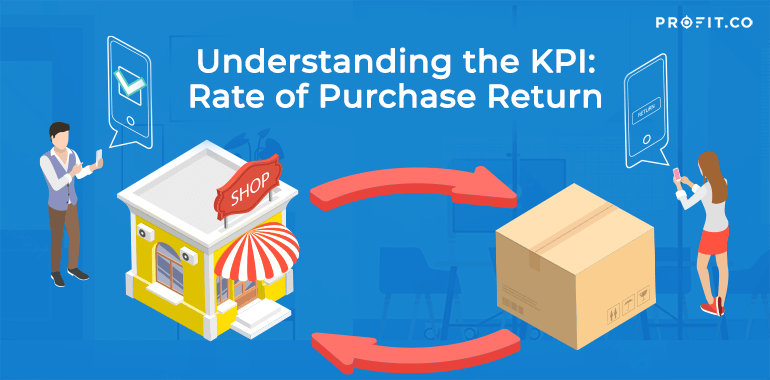Introduction
Understanding and effectively managing key performance indicators (KPIs) is essential to business operations. A critical KPI for managing your commerce business is the Rate of Purchase Return, which quantifies the frequency of returned products compared to the overall sales. This KPI is crucial for businesses, as it provides insights into customer satisfaction, product quality, and potential issues in the supply chain or sales process.
In this blog post, let’s dive into the mechanics of the Rate of Purchase Return and why it’s significant for commerce businesses.
What is the Rate of Purchase Return?
The Rate of Purchase Return is the percentage of products sold that customers eventually return.
Formula

Example
Let’s illustrate the concept of the Rate of Purchase Return with an example:
Imagine you’re running an online clothing store, and over a month, you’ve sold a total of 1,000 units of various items. During the same month, you received returns for 50 units.
To calculate the Rate of Purchase Return, you would divide the number of units returned by the total number of units sold, then multiply by 100 to get a percentage:
Rate of Purchase Return = (Number of units returned / Total number of units sold) x 100
= (50 / 1,000) x 100
= 5%
In this example, your Rate of Purchase Return for the month is 5%, meaning that out of 100 items sold, 5 were returned.
Remember, a low rate of purchase return is generally better, as it indicates fewer returns and, likely, higher customer satisfaction. If your rate is high, it might be a sign that you must look at factors such as product quality, accurate product descriptions, or your return policy.
Unlock the full potential of your business – start measuring your KPIs and see the impact on your bottom line!
The Importance of the Rate of Purchase Return
The Rate of Purchase Return plays a significant role in commerce businesses for several reasons.
Some reasons are the following:
1. Customer satisfaction indicator
A high Rate of Purchase Return may indicate a low level of customer satisfaction. If a business sees a surge in this KPI, it might suggest that its products or services need to meet customer expectations. Therefore, this metric can be a crucial tool for gauging customer satisfaction and can initiate improvements in product quality, customer service, or other relevant areas.
2. Product quality assessment
If a specific product consistently has a high rate of return, it may signal issues with the product’s quality. Constant monitoring of this KPI can help businesses swiftly identify and rectify quality issues, thus helping maintain the brand’s reputation and customer trust.
3. Effectiveness of sales and marketing efforts
Sometimes, a high return rate may be due to misleading or unclear product descriptions. With this insight, businesses can enhance their sales and marketing strategies to provide more accurate product information, subsequently reducing the number of returns and improving customer satisfaction.
A brand for a company is like a reputation for a person. You earn reputation by trying to do hard things well.
Impact of a High Rate of Purchase Return
The Rate of Purchase Return is a significant KPI, and a high rate can have multiple impacts on a business, spanning various departments and processes. These impacts can affect the company’s bottom line, operational efficiency, customer relationships, etc.
Here are some of the acute effects of a high Rate of Purchase Return:
1. Decreased profitability
Returned products often result in revenue loss, as they can only sometimes be resold at their original price. Additionally, costs are associated with processing returns, including transportation, handling, and repackaging. If the return rate is high, these costs can significantly impact the business’s profitability.
2. Increased operational costs
Returns involve a time-consuming process that requires resources for receiving, inspecting, restocking, and potentially repairing or discarding the returned items. The added complexity of returns increases operational costs and requires additional staffing, thus lowering operational efficiency.
3. Inventory management challenges
A high rate of returns can lead to uncertainty in inventory levels, making it more challenging to manage stock effectively. Overstock can lead to increased storage costs and the risk of obsolescence, while understock can lead to missed sales opportunities.
4. Customer satisfaction and trust
While an efficient return process can improve customer satisfaction, a high rate of returns might indicate more profound issues with the product quality or misleading product information. These returns may result from damaged customer trust and your brand reputation in the long run.
5. Sustainability concerns
The environmental impact of returns is an often overlooked aspect. Shipping returned products contributes to the company’s carbon footprint. Also, products that can’t be resold or recycled often end up in landfills, raising concerns about sustainability.
Strategic Approaches to Managing the Rate of Purchase Return
The Rate of Purchase Return is a crucial KPI for businesses, as it can impact various facets of operations, including profitability, customer satisfaction, and reputation. Managing this rate can significantly enhance business performance. Here, we’ll explore some strategies to help you manage and reduce your Rate of Purchase Return.
1. Understand the reasons for returns
The first step to managing the Rate of Purchase is understanding why customers return products. Are the products damaged or quality not expected? Categorize returns based on their reasons to identify patterns and underlying issues.
2. Improve product quality
Invest in quality assurance measures if returns are due to poor product quality. Make sure your products meet the quality standards promised to your customers. Regular quality checks and proactive communication with suppliers can significantly reduce returns.
3. Enhance product descriptions
If your products are being returned due to mismatches between the product description and the actual product, it’s time to revisit your product listing process. Ensure that product descriptions are detailed, and accurate, and provide all necessary information. High-quality images from different angles, videos, and size charts can help customers make informed purchase decisions.
4. Streamline return processes
Make the return process as smooth as possible. A hassle-free return experience can help maintain customer satisfaction, even when things go wrong. Clear instructions for returns, easy-to-find return policies, and efficient return service can significantly improve customer experiences.
5. Leverage customer feedback
Customers returning products are likely to have valuable feedback. Leverage this to improve your products, policies, and processes, enhance customer trust, and reduce the likelihood of future returns.
6. Train your customer service team
An effective customer service team can turn a return situation into a positive experience. Train your team to handle return requests professionally and empathetically. Empower them with the authority and resources to resolve issues promptly.
Managing the Rate of Purchase Return is an ongoing process. Implementing these strategies can reduce the Rate of Purchase Return and improve customer satisfaction, product quality, and, ultimately, the overall performance of your business. Remember, every return is an opportunity to learn, improve, and deliver a better experience to your customers.
Conclusion
Monitoring the Rate of Purchase Return can provide valuable insights into various aspects of a business, including customer satisfaction, product quality, and the effectiveness of sales and marketing strategies. Understanding this KPI is just the first step. Implementing strategies to improve business performance, profitability, and sustainability is crucial.
Profit.co provides versatile and intuitive OKR management software for your business’s needs and helps you track the Rate of Purchase Return seamlessly.

